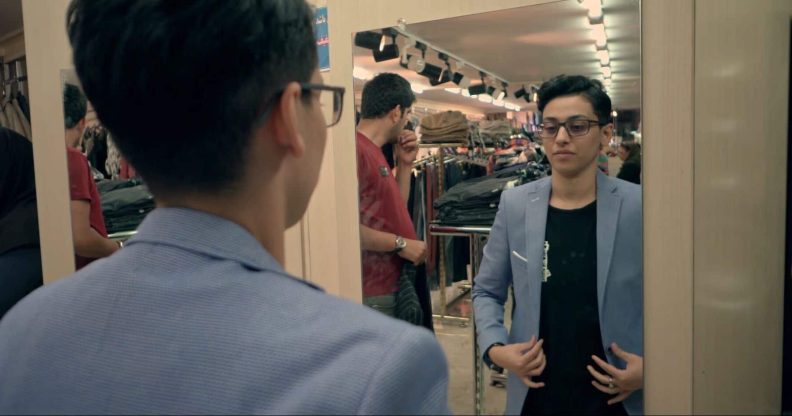Powerful film denounced by religious extremists spotlights complex lives of trans people in Iran

Scene from This is Not Me by Saeed Gholipour
Saman, a 27-year-old trans man, sits in a doctor’s waiting room with his parents.
They chat quietly, but his mother’s anxiety over the camera covertly placed on the seat next to them can’t be hidden. “I wish you wouldn’t film this,” she says, the distress in her voice audible.
It’s a poignant scene, and one which shows the risk that still comes with documenting the realities of trans lives in Iran. It’s one of many intimate moments in This is Not Me, a recently-released documentary by 27-year-old filmmaker Saeed Gholipour, currently showing at London’s BFI Flare film festival.
Although Gholipour isn’t trans himself, he felt compelled to make the documentary after witnessing a group of trans teenagers being verbally assaulted on the street. Nobody thought to defend them, largely because, he tells PinkNews, trans lives still aren’t fully understood in Iran.
This lack of understanding is no accident. When Gholipour set about making the groundbreaking documentary, news travelled quickly. Before long, he says, religious extremists had tracked him down and pressured him to partially censor his work.
Pressure from religious groups aside, Gholipour also had to contend with Iran’s film censorship laws, which were widely condemned by Iranian filmmakers in late 2020. “Because of these laws, he couldn’t show people making love,” says Amir, Gholipour’s translator. “He couldn’t show people without hijab, either.”
The effects of this censorship aren’t obviously apparent in the documentary. This is Not Me follows the daily lives of two young trans men, 16-year-old Shervin and 27-year-old Saman. Together, they navigate the trials and tribulations of coming out to their parents (both have supportive families), dealing with endless bureaucracy and developing thick enough skins to deal with the daily discrimination they face on the streets of Tehran.
There’s joy, sadness and everything in between, and This is Not Me does a commendable job of showing the day-to-day anxieties of being trans. In one scene, Saman longs to swim in the sea, but knows he’ll risk abuse if he does. Fully-dressed, he runs into the ocean in a scene of momentary euphoria. Seconds later, he’s back on dry land, his clothes clinging uncomfortably to his body as he tries to find a place to change.
Despite the specificities of being trans in Iran – the cultural emphasis on tradition, the fact that trans men still have to wear the headscarf that’s obligatory for women, at least until the court grants permission to remove it – there’s plenty to resonate with global audiences.
Clearly, the reception has been favourable. As we speak via Zoom – through Amir, a Farsi translator – Gholipour is rushing from one filming location to another, his internet connection shaky as he struggles to find a quiet location.
Gholipour had planned to travel to London for the festival, but his visa was rejected. Nevertheless, This is Not Me is travelling globally on its own merit, offering unprecedented access into trans lives which all too often remain entirely hidden.
PinkNews: What made you want to make This is Not Me?
Saeed: The idea came by accident. I was walking in Tehran when I saw a group of trans people being insulted on the street, and nobody stepped forward to help them. I realised that reluctance to help came from a lack of understanding of trans people and trans issues, so I decided to make this documentary both to learn about trans issues myself and to spread that knowledge, so people in Iran could be aware that trans people exist.
Does that awareness largely not exist right now?
In Middle Eastern culture, it’s fixed that you’re either a man or a woman and there’s nothing in between. The idea is that men are powerful, women are weak. So imagine, people are still grappling with the idea of gender equality, and now suddenly people are saying that trans people exist too, and you need to accept that and be knowledgable. It’s a big challenge.
There has been minor coverage of trans communities in Iran – in 2008, the BBC wrote that Iranian doctors perform the second-largest number of gender confirmation surgeries in the world, second only to Thailand. In your eyes, does this still check out?
I would actually say it’s true. There’s a lot of medical expertise about gender confirmation surgeries in Iran, and it’s been legal ever since the Iranian Revolution. Legally, there’s no issue. Culturally, there is. People in society can’t accept that this happens, which is why the documentary focuses more on the cultural barriers than the legal ones.
But there’s a lot of gatekeeping, right? In one scene, Saman complains about the endless paperwork and the need for a diagnosis. He says, “In Iran, everything is a disease.”
Absolutely, it’s a disaster. The government isn’t saying you can’t legally transition, but let’s break it down. If you want to be optimistic, you could say the process takes six months, but it could take two years, and those two years are a hassle. If you’re a trans man, you still have to wear the hijab until you get permission from the government. To get that permission, you need to go through plenty of psychological tests, which can be extremely insulting. You also need to take those tests in order to be signed off for surgery.
Despite this, the rates of confirmation surgery are high?
In many countries, it’s accepted to be trans and not have surgeries. In Iran, it’s seen as a condition of being trans – there’s a lot of cultural pressure, because then you’re seen to have transitioned to “male” or “female”, which fits the idea that you can only be a man or a woman. That cultural pressure is the reason Iranian trans people are a lot more likely to have surgeries.
In one scene, Shervin’s parents talk about needing to downsize their apartment to afford the costs. Were you surprised by how expensive it is to be trans in Iran?
Yes, it’s hugely expensive. The government gives some support, but to have a government-approved surgery can take ten years on a waiting list. If you go private, you’ll maybe get 10 per cent of the costs covered, and then you’ll have to pay the rest yourself.
There are some really touching scenes, and there’s a sense that both Shervin and Saman have huge family support. How important was it for you to show this more intimate side of their lives?
Well, this documentary wasn’t made under normal circumstances. I would have loved to have shown more of their private lives, to show that trans people can find love, but because the law doesn’t allow it, we just had to avoid it. Even with the censorship, I just really wanted to show people that this is what’s going on, and I wanted to do that with empathy.
When researching, did you come across any Iranian media coverage of trans women?
It’s strange, because legally there’s nothing to prevent media coverage of trans communities, but the media is still ruled by societal norms, so it’s not really covered. You can say, “Yes, trans people exist,” but most have their surgeries and then keep it extremely quiet. There’s also the religious extremists that contacted me; they would put a lot of pressure onto any media coverage, so there’s not really that much freedom to tell these stories.
Finally, what do you hope audiences gain from This is Not Me?
I tried to be really careful about showing too much, too soon. Because trans people still aren’t hugely accepted in Iran, I knew that people would be shocked and extremely guarded if we tried to push too many limits with this documentary. Ultimately, my aim was to raise awareness of trans communities in Iran. I wanted to show that yes, they do exist, and no, we can’t ignore that.

